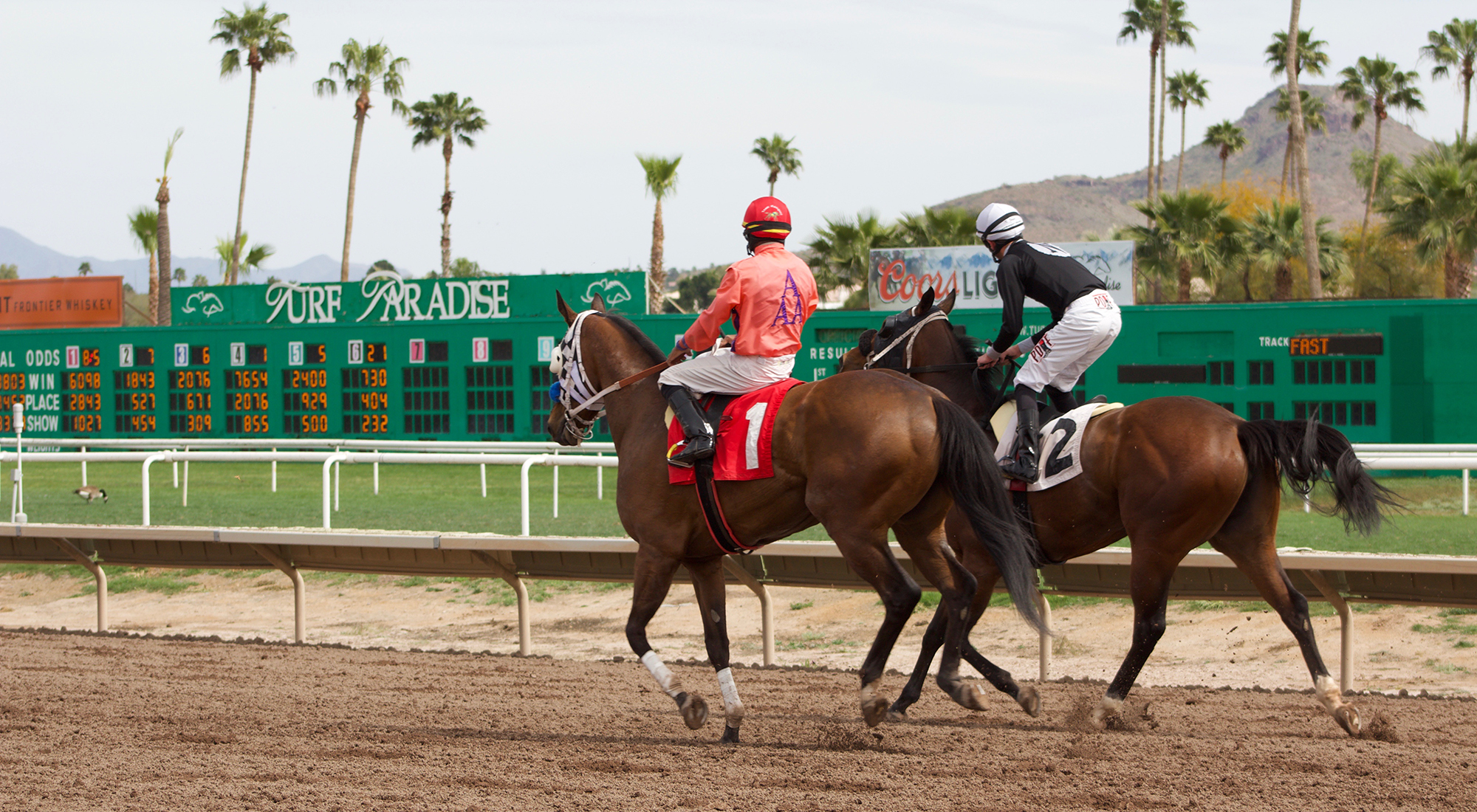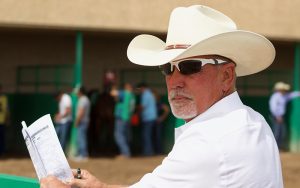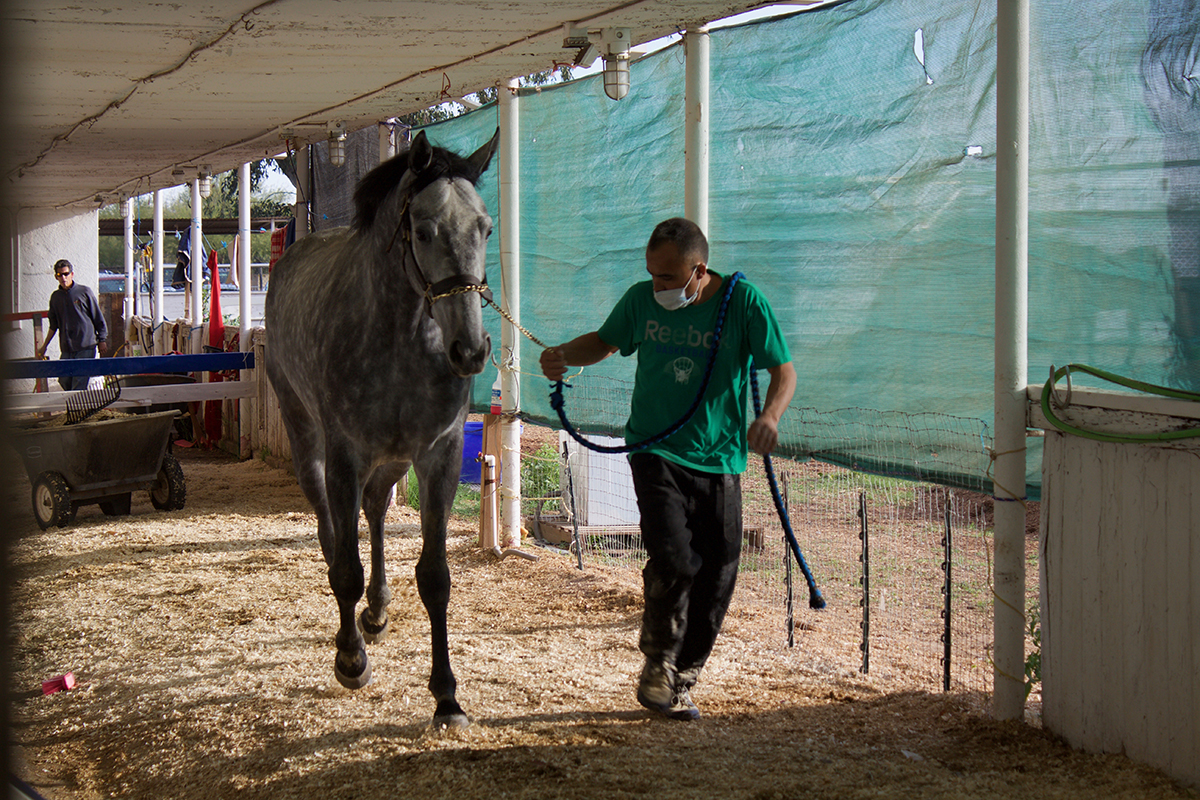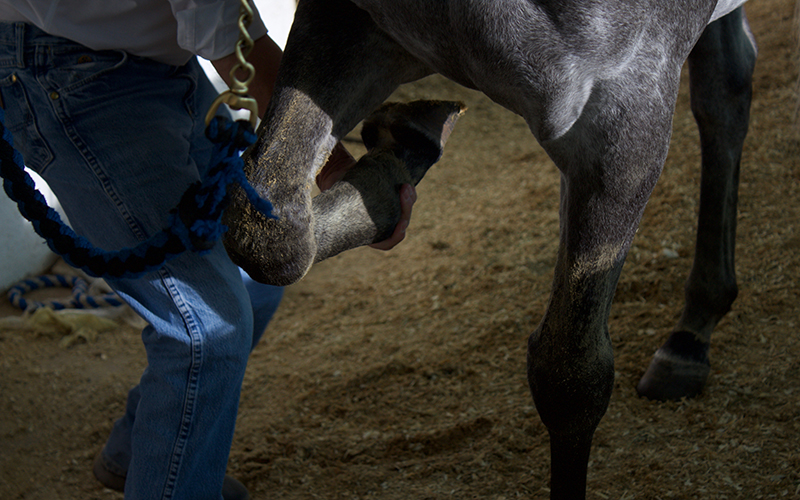
The number of horse deaths at Turf Paradise and other tracks around the country have alarmed the racing community. A leg fracture during a race often means a horse will be euthanized on site. (Photo by Jake Goodrick/Cronkite News)
Why are so many horses dying? Turf Paradise looks to find answers
By Jake Goodrick/ Cronkite News |
PHOENIX – Amid hundreds of stables and thousands of stalls that comprise the backside of Turf Paradise racetrack, Dr. Verlin Jones approaches Scott for Her with a smile and a “good morning.”
The 4-year-old mare’s trainer, Adriana Vallejo, guides the brown thoroughbred with a splash of white running the length of her nose out of her stall to be examined. Although the horse appears healthy, on this day she is slated to race, which means she must have a prerace exam.
It has become common practice at Turf Paradise, where officials announced in January they are investigating an uptick in equine deaths since the track’s 2017-18 meet, more than double the national average.
It is a story line that has dominated national headlines. The disqualification of Maximum Security in Sunday’s Kentucky Derby raised questions about horse safety and came just a month after reports that 23 thoroughbreds have died during races or training at California’s Santa Anita Park since late December.
“This is our life,” jockey Scott Stevens said. “This is how we make a living and you know, if you don’t love the horse, you don’t belong on the backside.”
The track’s priority now is to find an answer to this question: Why are so many of its horses dying?
Jones hopes the mandatory prerace exam can help provide some of them. Dressed in stone-washed Wrangler jeans and a white button-down shirt with the sleeves rolled to his elbows, he calmly approaches Scott for Her and gently lifts her front left leg, which he bends at the knee. He feels for the fluidity of her joint movements.
“Well, I take a look at the knees, the ankles, the tendons and ligaments – see if they’re normal just on observation,” Jones said. “And then when I watch the horse go, I want to see how he travels. Is he traveling sound? Is he a little bit off? How’s he moving?”
After examining each front leg, Jones assuredly pats his hand down Scott for Her’s back, feeling for any abnormalities while signaling to the horse that he’s approaching her hind legs. He bends her back legs inward at the knee – inspecting them the same as the front – before setting her hoofs back on the dirt ground of the shedrow.
At the end of the exam, Jones instructs Vallejo to jog her horse down the row of stalls and back, so he could look for any oddities in the mare’s stride.
She passes the inspection, as did the other 64 horses examined by Jones and his counterpart, Dr. Jeff Aldridge, on this race-day morning at Turf Paradise.
Prerace exams used to be given out sporadically at Turf Paradise – about 15 horses per race day, chosen at the steward’s discretion – but that changed recently in lieu of an increase in breakdowns on the track, and consequently, a spike in horse fatalities.
Arizona experienced 50 combined equine deaths related to afternoon racing, training and non-exercise related deaths, according to a report of the 2017-18 racing season. Training and non-exercise deaths, with 19 total in the state, came in close to the national average.
The same could not be said for the 31 racing-related fatalities, 27 of which occurred at Turf Paradise.
In 2017, nationally there were 1.61 equine deaths per 1,000 starts, a start being defined as a horse that leaves the paddock for the post. However, Arizona averaged 3.41 deaths per 1,000 starts, more than double the national average, according to the 2017-18 Arizona Fatality Breakthrough Project form the Arizona Department of Gaming.
Breakdowns occur suddenly and are typically caused when a horse fractures a bone on the track. Thoroughbred and quarter horses usually found on race tracks are unable to lie down for extended periods of time to rest their injuries, and therefore have virtually no chance of recovering.
When a breakdown occurs, the horse is euthanized on-site after a medical evaluation and then carted off the track.
Turf Paradise runs a much longer meet than the two other horse racing tracks in Arizona – Rillito Race Track in Tucson and the Sonoita County Fairgrounds – which explains why Turf Paradise experienced the bulk of the equine deaths in Arizona. Still, Turf Paradise General Manager Vincent Francia characterized the loss of even one horse as devastating.
“Any death – one horse suffering a fatality – is too many for us,” Francia said.
The race track embraced reform in an effort to understand the possible reasons for the unusually high number of deaths in hopes of solving the problem.
“We haven’t been able to put our finger on a specific cause of what’s contributing to these fatalities,” Francia said. “And by ‘we,’ I mean it’s not only the race track, it’s the horsemen, it’s the (Department of Gaming Racing Division), which is the agency which regulates the race track.”

Dr. Verlin Jones isn’t convinced mandatory prerace exams have a correlation to the horse deaths. (Photo by Jake Goodrick/Cronkite News)
In addition to administering prerace exams on each horse scheduled to race on a given day, Turf Paradise reached out to universities for help analyzing their statistics to determine potential causes for the increased number of breakdowns.
Also, Turf Paradise announced that it will no longer host flat track motorcycle racing, which the track first hosted in the offseason before the uptick in breakdowns began. Although there is no indication that the motorcycle racing has affected the condition of the track for horse racing purposes, Turf Paradise took added precautions.
In response to the uptick, the Arizona Department of Gaming created a task force to evaluate the effectiveness of the added preventative measures and to determine whether further measures should be taken.
“As part of this effort, we convened a multidisciplinary group of racing and veterinary professionals and horsemen, researched equine safety, and provided reports with recommended actions to prevent and reduce breakdowns, which aligned with industry standards,” the Arizona Department of Gaming said in an email.
As Arizona’s most active horse racing track, Turf Paradise experienced 27 racing-related horse deaths alone during the 2017-18 meet. After experiencing breakdown occurrences on par with its 2017-18 meet during the first half of 2018-19, the issue has showed signs of improvement during the past few months.
Turf Paradise experienced 19 total “catastrophic breakdowns” related to racing so far this meet, Francia said, including only two breakdowns in February and March combined, which suggests an improvement – at least temporarily – to the inexplicable and tragic issue.
“So, I’m hoping we’re going the right direction, you know,” Jones said. “I don’t really believe what I do in the morning (administering prerace exams) has a direct correlation on the deaths.”
Turf Paradise acknowledged the problem and is seeking answers. There remains little indication, however, that it or the racing industry at large is any closer to finding a definitive cause, let alone a solution.
“We function as a community,” Francia said. “We know each other, we see each other every day. And when a breakdown happens, horses are part of our family. I mean, anybody in the racing business, be it in management or in the stable area, they are part of the family. And when you lose one, everybody feels it.”
The backside
Chaplain John Shumaker stands in front of his congregation with an acoustic guitar in his hand. As the churchgoers welcome each other with hugs and hellos, Shumaker – donning a neat, gray goatee, a collared shirt of the same gray hue and light denim jeans tightened by a thin, brown belt – strums his opening chords and summons the audience to their metallic-folding-chair pews, as well as to attention.
Each note echoes throughout the modest church hidden among a sea of stables behind the track. The small room of wood-paneled walls and mud-splashed blue carpeting come to life as worshipers sang along with country-inspired, twangy hymns on a Sunday morning.
The collection of 30 or so men, women and children who attended Shumaker’s service are a small sample of those who spend their days in the ecosystem that exists within Turf Paradise. Together, they make up a subculture of working class men and women who own, care for and race the horses there.
And they all want an answer to the same question: Why are so many of their horses dying?
Jockey Stevens, 58, has been at Turf Paradise since the 1992-93 meet and is familiar with the inner workings of the backside.
“Everybody back there, most of their horses are treated like royalty, they really are, no matter if they’re a cheap claimer or a stakes horse,” he said.
Turf Paradise’s backside includes hundreds of stables and, during its meet, hundreds of owners, trainers, grooms and other horsemen who tend to the horses and work behind the scenes to ensure the horses are ready to go come race day.
The horse racing community is transient by nature. For those who spend their lives working at different race tracks across the country, at different times of year, it can be difficult to establish and re-establish roots in new communities.
Many workers return to Turf Paradise year after year, but others come and go.
As the Turf Paradise chaplain, Shumaker, who declined to comment about the uptick in breakdowns, and his church have a role in orchestrating a collective sense of community behind the scenes at Turf Paradise.
“The chaplain, he comes in every day before the races and prays with the jockeys and the gate crew,” Stevens said. “He has church on Sundays. … He’s there for support.”
Along with the church, the backside also has a separate bar and restaurant, added touches that round out the limited stable area amenities and offer places to gather.
“This is home,” Stevens said. “It’s seven days a week. The horse has to eat and drink twice a day so everybody’s there seven days a week taking care of their horse. It’s a way of life.”
The big picture
Turf Paradise is not the only U.S. horse racing track that recently experienced breakdowns at an alarming rate.
Santa Anita Race Track closed its operations from March 3 to March 29 after 22 horses experienced breakdowns and died from the time the meet began on December 26 until the closure. The track reopened after the California Horse Racing Board approved new restrictions on medications and banned the use of riding crops, according to a Santa Anita press release. Another horse died three days after the reopening.
“Now what has changed, because of all that has been happening at Santa Anita, is we’re all under the microscope,” Francia said. “It’s not just Santa Anita, it’s Turf Paradise, it’s every race track in America. We are all under that microscope now, and that’s because public sentiment is at a level that they are demanding that in this sport, if we’re going to do it, that all the corrective measures that can be taken have to be taken in order to ensure the welfare of the horses.”
Santa Anita is a higher-tier race track than Turf Paradise with larger purses and, consequently, a different grade of animal, Jones said.
“More money in the purse structure brings in a higher quality of horse,” Jones said. “Right now in Arizona we have probably mid-level to low-level claimers. That population of horses comes with their own set of problems, so we deal with horses that have a higher level of injury than other tracks with a higher purse structure.”

Down Hill Run finishes up a prerace exam so the training staff can keep a close eye on the horse’s movements. (Photo by Jake Goodrick/Cronkite News)
For over 30 years, Jones worked as a private practitioner on the veterinarian side of the horse racing industry on race tracks across the country. Jones said that the current industry status quo of increasing medication regulations when faced with incidents such as the ones that occurred at Santa Anita and Turf Paradise may actually be a factor in the trend toward increased breakdown rates at some of the lower-tier race tracks nationwide.
“I think that right now these private practitioners on the back side, their hands are really, really handcuffed,” Jones said. “When you’re dealing with this level of horse – these are low-level to mid-level claimers – they have a lot of problems. Those problems can be taken care of, but we have to have our full arsenal in order to do that.”
Jones said that whether more restrictive medication policies will decrease the number of breakdowns, regardless of a track’s purse structure, remains unanswered.
“I really feel like horses today are having to run in more pain,” Jones said. “More pain leads to muscle fatigue, muscle fatigue leads to bone fatigue, bone fatigue leads to catastrophic breakdowns.”
Francia sympathized with the anti-regulations viewpoint but suggested that the answer to the issue is likely to reside somewhere between the anti- and pro-regulation sides of the argument.
“I understand where the vets are coming from, I do, because they treat these animals,” Francia said. “But, there’s got to be a middle ground between doing what management, or many in the industry feel is doing the best thing for the horse as compared to pharmaceutically keeping these horses running. That is not a good thing.”
The many industry opinions that surround the issue of horse safety are indicative of the complexity of the issue at hand.
“Equine breakdowns are the number one issue facing the racing industry both nationally and in Arizona,” The Arizona Department of Gaming said in an email. “Further, each track has unique characteristics that play a role in equine safety.”
The parties involved hope to improve the safety of horse racing while preserving the sport itself, but the lack of concrete evidence as to the cause of the catastrophic breakdowns further complicates the question of how to best resolve the issue.
“It would be easier for all of us in the industry if it were just one thing, but it is not just one thing,” Francia said.
The race day
After Jones made his morning rounds administering prerace examinations throughout the stable area, he found his way through the labyrinthine backside and on to the main race track itself.
As the trainers of each of the eight participating horses escorted their animals to the paddock, Jones – now with a pale Stetson hat rested on his head and dark tinted shades drawn over his eyes –observed with a watchful eye. Although all of the horses passed their prerace exams, breakdowns can occur to even an ostensibly healthy horse, so he looked on and used his decades of race track veterinarian experience to conduct an eye-test of his own.
Race after race went by without incident. Each time, Jones followed the horses as they loaded into the starting gates and communicated with their jockeys in search of any abnormalities that could suggest an undetected injury.
Finally, race eight, the final race of the day. Scott for Her, the five-year-old brown mare who Jones inspected that morning, made her way to the gate without incident and passed Jones’ final eye-test inspection in the process, ready for the 5-and-a-half furlongs maiden claimer to begin.
To that point, each race had gone without incident. That changed when, Jones said, Tails Never Fails – another five-year-old brown mare – approached the gate and, spooked by the gate hand’s attempt to lead her to her starting place, reared backward. The horse recovered by standing to her feet, but Leonel Camacho-Flores, the jockey she landed on, was less fortunate.
On-site paramedics attended to the jockey and he was eventually escorted to the hospital after an unexpectedly long ambulance wait, despite Arizona regulations that mandate an ambulance to be on stand-by at the track for morning training and races, as reported by The Arizona Republic. Camacho-Flores fractured several bones in his pelvis but survived.
After sending Tails Never Fails back to the paddock for another rider, the other horses became restless and the remaining jockeys decided to call the race, Jones said.
“The jockeys have a lot of authority on a race track,” Jones said. “It’s their call if they think the track is unsafe, they think something is not right, they can call it. They’re the ones who make the call.”
Despite the incident at race eight, no horses died that day and as of late, there have been fewer breakdowns at Turf Paradise.
The first half of the meet quickly matched the average breakdown rate from last year that doubled the national average. Fifteen horses died from racing-related breakdown at Turf Paradise from the beginning of the meet in October through January. However, the track only experienced four total breakdowns in February, March and April combined, Francia said.
According to the Arizona Department of Gaming, it has seen a 30 percent decline in the number of catastrophic injuries at all Arizona race tracks since it added the most recent safety precautions for the 2018-19 racing season.
Since then, Turf Paradise’s breakdown rate decreased from a high of 3.4 incidences per 1,000 starts to 2.2 incidents per 1,000 starts, the Arizona Department of Gaming said.
Jones offered theories about the drop-off in breakdowns. For one, the mandatory prerace exams may have caused owners and trainers to scratch horses in questionable health for fear of being flagged in the exams. But Jones said it also could simply be a regression to the mean.
“I can’t sit here and take credit and say that the reason we’re not having as many breakdowns is because we’ve done this or that, X, Y and Z,” Jones said. “I honestly believe that the law of averages catches up with you, and the law of averages moved in our favor.”
The reason for the recent downturn in equine deaths may be as unexplained as the cause of the initial increase.
But for a community reeling from the loss of its horses, and a race track perplexed by its status as an unwanted outlier in its industry, it is a welcomed change nonetheless.
Follow us on Twitter.





Leave a Comment
[fbcomments]